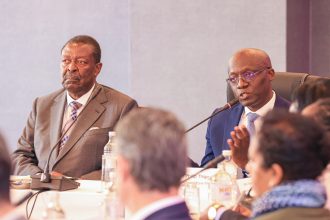By Duncan Mboyah
Nature Kenya, a Kenyan conservation group has urged the government to redesign High Grand Falls dam for downstream human survival, wildlife ecology and climate change mitigation.
Dr. Paul Matiku, the Executive Director of Nature Kenya said the project benefits should not come at the expense of the people, wildlife, livestock, development and climate change mitigation downstream.
“A balanced sustainable approach is essential to maximising the project’s advantages while proactively mitigating its ecological, social and economic risks,” Dr. Matiku told journalists in Nairobi.
Dr. Matiku noted that while Nature Kenya supports the potential benefits of hydropower and improved water supply, it emphasizes the need for strong mitigation measures to ensure development does not harm ecosystems, biodiversity, and local livelihoods.
He noted that the project as it is, does not adequately address water availability to meet competing water demands.
The official added that without a clear water resource use and allocation plan, there is a high risk that water flowing downstream into the delta – a designated Ramsar site – will be below the recommended ecological limit of 60 cubic meters per second at Garsen.
Dr. Matiku said Nature Kenya recommends incorporating critical ecological and social safeguards into the dam’s design by ensuring a minimum water flow of 60 cubic meters per second at Garsen to sustain downstream ecosystems and livelihoods.
Nature Kenya, added, also recommends prevention of silt build-up in the reservoir while ensuring soil fertility downstream as well as constructing a secondary storage dam to manage water release for stable downstream supply.
“Allow migratory fish species like eels to move upstream, address critical gaps in biodiversity protection and water demand assessments, engage downstream communities in decision-making to ensure equitable water distribution and implement a sustainable water management plan that balances economic benefits with environmental conservation,” he added.
He said the High Grand Falls Dam must be developed responsibly to protect Kenya’s natural heritage and secure sustainable livelihoods.
“Conduct a strategic environmental assessment to assess whether River Tana can support all intended uses – supporting irrigation, Lamu Port needs, and maintain the flow of 60 cubic metres per second at Garsen, which is essential for people and nature in the Tana Delta,” he added.
The planned hydroelectric power station across the Tana River is being built by Kenya to harness the energy of the Kibuka Falls to produce a capacity of 693 megawatts and is expected to provide electricity for industrial development when complete.
The Tana River Delta is one of these places where Kenya aims to produce food on 200 acres with water diverted into irrigation canals for food production from the dam.




